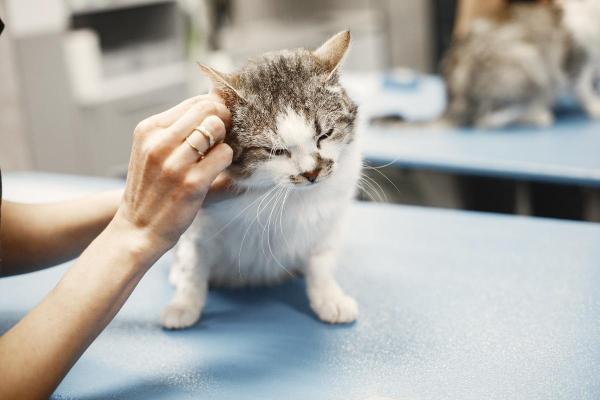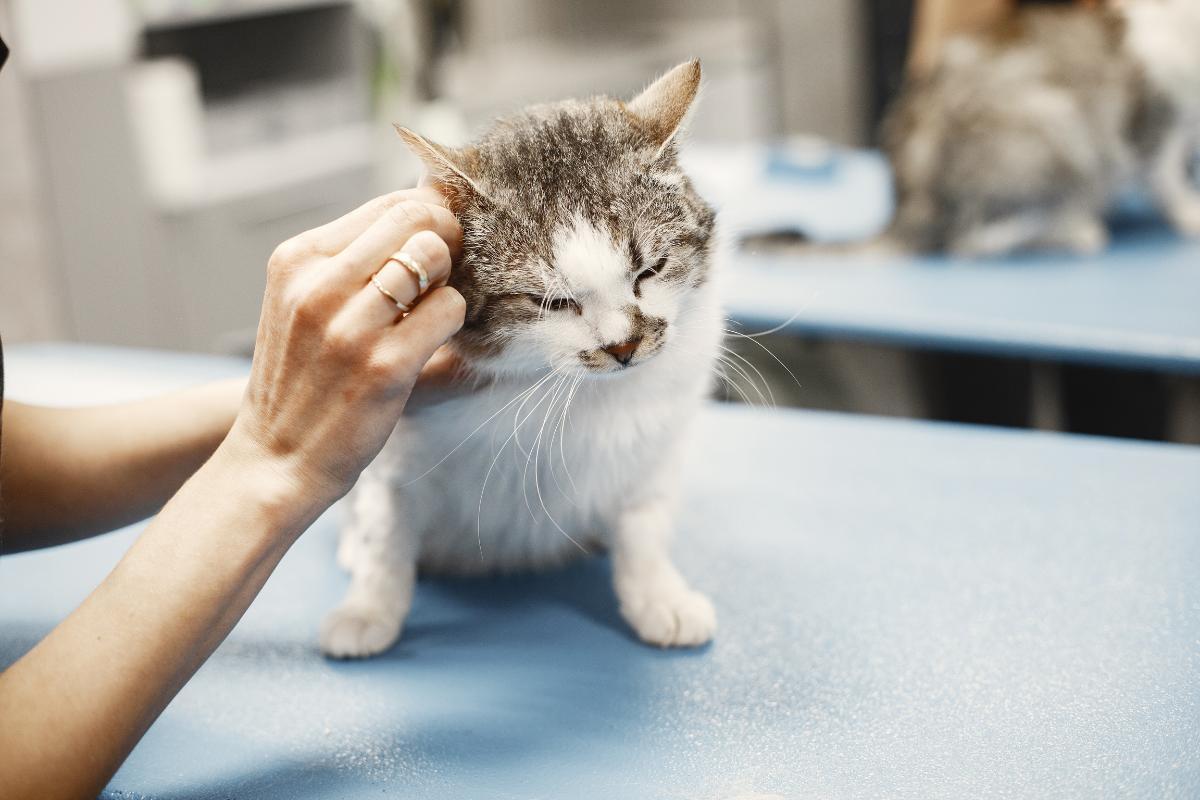Aural Hematoma in Cats - Causes and Treatment



See files for Cats
Also known as otohematomas, aural hematomas are an accumulation of bloody fluid in the ear. Specifically, the blood accumulates between the cartilage of the ear and the skin causing inflammation. There are various causes of feline aural hematoma, both primary and secondary. For example, a primary cause may be direct trauma to the ear and a secondary cause may be the result of an allergic reaction. They can be quite painful for the dog, but they are considered treatable in most cases. This will depend on the underlying cause. Treatment is varied, but includes surgery in most cases.
Learn more about aural hematoma in cats with AnimalWised. We look in greater detail at the causes, symptoms and treatment of ear hematoma in cats, as well as what you can expect in terms of diagnosis and prognosis.
What is aural hematoma in cats?
The otohematoma is an inflammatory process which affects the auricular pavilion or cartilaginous sheet of the ear. Unlike many other types of inflammation, aural hematoma is due to the accumulation of blood within the cat's ear (a type of seroma). Secondary to this accumulation of blood, there is inflammation on the inner side of the auricle that has a soft, fluctuating and well-defined appearance. It appears as if there is a soft bag on the side of the cat's ear.
It is a problem which is more common in dogs than in cats and is independent of sex, breed and age. The origin of the accumulated blood belongs to the branches of the greater auricular artery present within the cartilage of the ear. When it develops, it is often damaged or fractured by intense or abrupt scratching by the cat. This is as a consequence of the painful or pruritic processes the cat can suffer during an aural hematoma.
Learn more about this condition in canines with our guide to aural hematoma in dogs.
Symptoms of an aural hematoma in cats
You will likely first detect a feline aural hematoma because you observe that your cat's ear is swollen. This is because it manifests as a soft lump in the cat's ear due to the build up of blood which may be accompanied by other fluid. The cat's ear will feel hot to the touch due to the blood inside. If the hematoma is allowed to develop sufficiently, it will result in fibrosis. This means it will start to harden and become firmer to the touch.
Clinical signs associated with otohematoma in the feline species include:
- Pain
- Scratching or shaking of the ear
- Lateralization of the head side of the affected ear (i.e. sloping to one side)
- Head movements due to irritation, itching or pain
When the otohematoma in cats is large, we can see how the affected ear droops more than the healthy one. This is something which can occur with other ear problems in cats.

Causes of aural hematoma in cats
Despite the fact that the cause itself is not entirely clear, it is assumed that feline aural hematomas are produced as a result of the action of external forces on the auricular pavilion of our small cats. These external forces consist of direct trauma such as jerking of the head from wanting to scratch due to:
- Itching
- Pain
- Irritation
- Intense discomfort
This frequent traumatic action ends up causing the blood vessels to rupture and the blood to be released. The blood will then begin to accumulate in the auricular pavilion, producing the ear hematoma.
Trauma is not the only suspected cause of an aural hematoma in cat. Other processes which can result in such a swelling of the cat's ear include:
- Allergies: as a response to a particular allergen, otitis in cats can develop (i.e. swelling of the ear). If this affects the auricular pavilion, it can result in blood accumulation and an aural hematoma.
- Parasites: parasites also cause a response in the body's immune system, potentially resulting in inflammation and aural hematoma. The irritation caused by external parasites can cause scratching which leads to trauma. Common ear parasites in cats include Otodectes cynotis, mites which can infest the ear due to poor hygiene and other issues.
- Foreign bodies: small embedded foreign bodies such as small twigs, spikey plants or broken glass can become embedded in the cat's ear. This can result in the cat scratching their ear repeatedly due to the irritation it causes.
- Internal pathologies: certain diseases can result in vascular fragility. Since hematomas are caused by blood leaking in places it shouldn't, a disease can cause blood vessels in the ear to break and inflame.
- Decreased immunity: whether due to an underlying immunological disorder as the cause, it may predispose them to issues such as secondary aural hematoma.
Diagnosis of aural hematoma in cats
Diagnosing an aural hematoma is relatively easy. The swelling will be evident and the texture of the ear can alert a veterinarian to the problem. In addition, blood is darker than most other bodily fluids, so they will likely be able to see it through the thin skin of a cat's ear. If the cat has been scratching excessively, there may also be evidence of the marks on their skin which can indicate a possible hematoma.
To confirm diagnosis of aural hematoma in cats, it is enough to obtain a sample of the inflammatory fluid via aspirating part of the ear. When the reddish liquid corresponding to a seroma rich in fibrin and blood, it will be diagnosed as a hematoma. If you notice any of the symptoms of aural hematoma in cats mentioned above, go to a veterinarian immediately. There are other inflammatory processes such as tumors can cause lumps under a cat's skin, but only a qualified professional can diagnose conclusively.

Treatment of aural hematoma in cats
Once diagnosed by the veterinarian, they will outline the possible treatment options for aural hematoma in cats. Treatment can be either medical or surgical, although it is most commonly the latter. For this reason, there are no home remedies for aural hematoma in cats.
With regard to medical treatment, a mild hematoma may be drained using aspiration. This is when a lancing instrument pierces the swollen area to draw blood away. A compression bandage will then be placed on the aspiration site. Pharmacological treatments will be used alongside to prevent further accumulation of blood. This includes the possible use of corticosteroids. If reoccurrences are frequent, they will require surgery.
Surgical intervention of aural hematoma in cats
Surgery is usually the best option for any kind of feline aural hematoma. This consists of removing the fluid content and avoiding reoccurrences. It should also return the ear to its original appearance as the swelling will subside.
There are several techniques such as:
- Passive drainage with Penrose drain
- Active draining
- CO2 laser
- Intradermal Punch biopsy suture with simple stitches
- S-shaped incision with staggered sutures after draining
The latter option is the most commonly used. The S-shaped suture allows a more thorough draining of the area. It will require thorough cleaning of the external ear and auditory canal.
Any fibrosis should also be removed to avoid retraction of the ear cartilage. Without its removal, it could cause any of the stitches that are given in the surgery to fall out. A temporary sutured sponge is applied to the inside of the auricle, pressing and sucking the affected area, which will be removed a few days after the procedure.
This treatment is accompanied by an Elizabethan collar to prevent the cat from touching the area and treatment with analgesics, anti-inflammatories and antibiotics for secondary infections. General hygiene of the ear is important, something you can learn about in more detail with our guide to cleaning a cat's ears.

This article is purely informative. AnimalWised does not have the authority to prescribe any veterinary treatment or create a diagnosis. We invite you to take your pet to the veterinarian if they are suffering from any condition or pain.
If you want to read similar articles to Aural Hematoma in Cats - Causes and Treatment, we recommend you visit our Skin problems category.
- Harvey, A., & Tasker, S. (Eds). (2014). Feline Medicine Manual. Ed. Sastre Molina, SL L ́Hospitalet de Llobregat, Barcelona, Spain.







